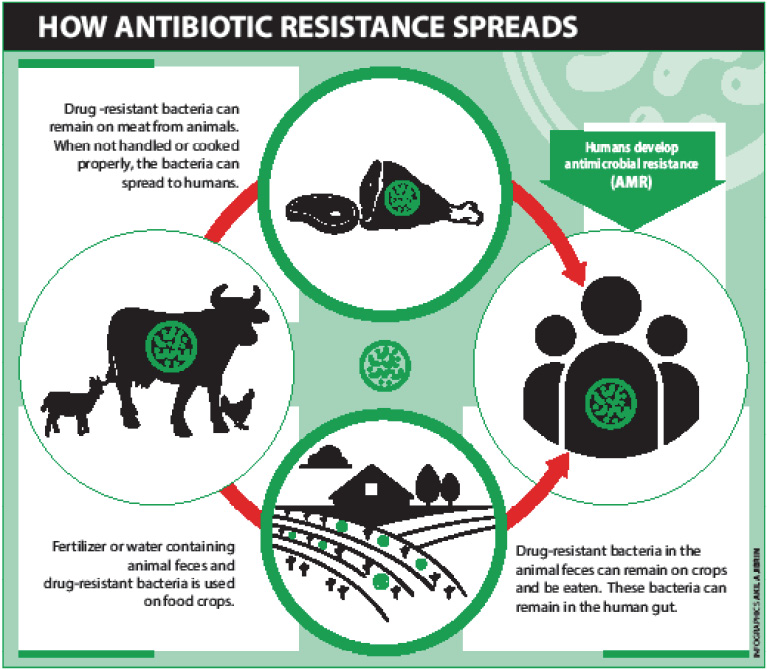…AMR to cost $32tln by 2050 — W/Bank
Indiscriminate use of antibiotics in livestock farming has raised serious public health concerns globally. In sub-Saharan Africa and particularly in Nigeria, it is more endemic among poultry farmers.
Antibiotics are used for three main reasons: to boost the growth of the animals and birds; to treat flu-like infections and to prevent any eventual disease attack.
Antibiotics are powerful medicines that fight bacterial infection. When bacteria develops resistance to the antibiotics, it is termed Antibiotic Resistance (ABR), while Antimicrobial Resistance (AMR) occurs when disease-causing organisms (bacteria, viruses, parasites) can no longer be killed by antimicrobial agents.
Dr E. Wesangula, AMR Focal Point of the Kenyan Ministry of Health at the just concluded African Conference of Science Journalists, Nairobi, Kenya painted the looming danger to public health as a result of indiscriminate use of antibiotics in animals.
His position reflects the grave concern expressed in Nigeria by the Nigeria Veterinary Medical Association headed by Professor Mohammed Bello Agaie.
Dr Wesangula noted that the use of antibiotics in livestock today is even greater than in humans. The health expert expressed worry that “in many villages, farmers use human antibiotics to treat chicken to control flu-like infection.”
By consuming meat, egg or milk with antibiotics residues, one under-dosed himself by exposing his microbes to non-lethal quantities of the drug, which will make them resistant to many antibiotic drugs when he is sick.
Professor Bello Agaie explained how humans become the victim of the antibiotic used in livestock: “When you use it in food animals, there is a period that has been specified – we call it withdrawal time. For the professionals, that animal should not be slaughtered within that period or else the residues will still be available in the product – either milk or meat.
“So if you eat meat, eggs or drink milk or eat cheese, you’re taking those antibiotics in very low concentrations.”
Professor Agaie said that the practice “is worse in poultry. What we have is people produce a cocktail of drugs – two, three, or four antibiotics which they put into one – whether the birds are sick or not, they keep putting it into the water. They think it will enhance their growth, make them healthier or not come down with any disease.
“While this is happening, the birds are laying eggs, they are maturing as broilers and we are eating them. So we now get exposed to very low concentration of antibiotics and when people go to hospitals when sick they give you drugs, it does not work because you have already been exposed to some sub-lethal concentration of this drugs…. And the organisms themselves have found a way to now dodge the effect of the drugs so the drugs are no more effective.
“The second thing is that even if you say I’m not eating meat, eggs or taking milk, you say you want to go green, you collect faeces from animals – chickens, cow dung, and you fertilize your soil, you will contaminate the soil. So when you plant, the crop also takes the antibiotics,” he explained.
Consuming crops produced with wastes of animals with antibiotics residues also exposes one to the low quantity of the drugs, which will make your microbes develop resistance to antibiotic treatment.
According to Dr Wesangula, about 4.2 million people in Africa are likely to die due to antimicrobial resistance.
The World Bank estimates global healthcare cost of more than $32 trillion by 2050.
It also said that by 2050, the decline in global livestock production could range from a low of 2.6% to a high of 7.5% per year
“There would be a pronounced increase in extreme poverty because of AMR. Of the additional 28.3 million people falling into extreme poverty in 2050 in the high-impact AMR scenario, the vast majority (26.2 million) would live in low-income countries.
Currently, the world is broadly on track to eliminate extreme poverty (at $1.90/day) by 2030, reaching close to the target of less than 3% of people living in extreme poverty. AMR risks putting this target out of reach,” the World Bank 2016 said.

 Join Daily Trust WhatsApp Community For Quick Access To News and Happenings Around You.
Join Daily Trust WhatsApp Community For Quick Access To News and Happenings Around You.

